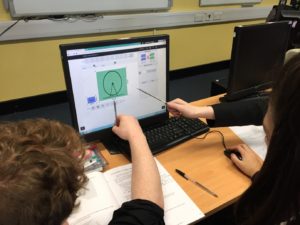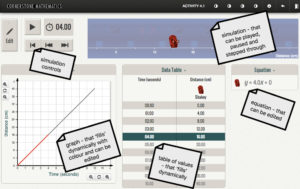One of a series of blogs on ‘building and sustaining active research collaborations with teachers of mathematics’
Written by Alison Clark-Wilson and Celia Hoyles:
A recent research study, Developing teachers’ mathematical knowledge using digital technology funded by the Nuffield Foundation has concluded aspects of the particular new knowledge and pedagogies that are demanded when teaching with ‘dynamic mathematical technologies’ (DMT). By DMT, we mean software that uses sliders, dynamic mathematical objects and connected animations that enables pupils and teachers to interact directly with the ‘nuts and bolts’ of the mathematics.
The study set out to research the impact on teachers’ mathematical knowledge and practice as they began to use dynamic mathematical technologies (DMT) in their teaching of key topics in key stage 3 maths. This is set within the context of known underuse in English mathematics classrooms (Bretscher, 2011).
During the two–year project, we gave 200 teachers from 42 London schools a tried-and–tested (Sturman & Cooper, 2012) mathematics curriculum (Cornerstone Maths) embedding dynamic maths technology (DMT) covering part of KS3 (algebraic generalisation, linear functions and geometric similarity). The teachers participated in research-informed using cycles of planning, teaching and evaluation that formed an integral and important part of the research methodology. The research identifies a number of effective classroom practices and points to the necessary conditions for these to happen.

As the teachers trialled and evaluated the DMT in their classrooms, the research concluded that the process of integrating DMT within secondary mathematics teaching presents considerable potential for (teachers’) learning as they embraced the professional challenges that required them to:
- rethink the underlying mathematical concepts, given that the dynamic elements offer new representations that make the mathematics more tangible.
- dedicate time to both become personally fluent with the technology and develop how they will exploits its dynamic features in their teaching.
- develop their ‘curriculum script’ – the vocabulary and questioning to support pupils’ technological experiences such that lessons maintain a high mathematical focus.
Professional development to support teachers to implement DMT in their classrooms needs to blend face-to-face sessions that involve first-hand experiences with the DMT alongside PD tasks that deepen teachers’ understandings of the mathematics at stake and promote lesson planning for common activities. The cyclical PD approach (Sutton Trust Report, 2015) that adapted ‘lesson study’ over a period of 6–8 weeks, was a model reported to be successful by the participating teachers. This PD seemed to have further impact where groups of teachers participated in communities of practice within their own schools.
The sustainability and scaling of classroom practices that embed dynamic technology beyond the funded project is being addressed through a research-informed web-based professional development toolkit (PD Toolkit) that embeds the use of landmark activities as boundary objects for school-based PD.
Alison Clark-Wilson and Celia Hoyles
a.clark-wilson@ucl.ac.uk
UCL Knowledge Lab
UCL Institute of Education
References:
Bretscher, N. (2011). A survey of technology use: The rise of interactive whiteboards and the MyMaths website Paper presented at the Seventh Congress of the European Society for Research in Mathematics Education, Rzeszów, Poland.
Sturman, L., & Cooper, L. (2012). Evaluation of Cornerstone Mathematics Pilot in England: Unit 1, linear functions. Berkshire: National Foundation for Educational Research.
